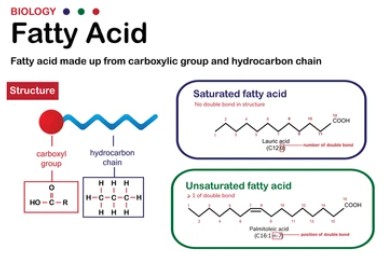
Fatty acids are long aliphatic hydrocarbon chains containing a carboxyl group at one end. According to the different lengths of carbon chains, fatty acids can be divided into short-chain fatty acids, medium-chain fatty acids, and long-chain fatty acids. According to the difference between saturated and unsaturated hydrocarbon chains, fatty acids can be divided into saturated fatty acids, monounsaturated fatty acids, and polyunsaturated fatty acids. Fats rich in monounsaturated fatty acids and polyunsaturated fatty acids are liquid at room temperature, mostly vegetable oils, such as peanut oil, corn oil, soybean oil, nut oils, canola oil, etc. Saturated fatty acids, mainly composed of fat at room temperature, are solid, mostly animal fats, such as butter, mutton oil, lard, etc. Plant fatty acids have essential physiological functions, great food, and industrial value. Lifeasible provides professional plant fatty acid testing services for global customers, including various long-chain fatty acids and short-chain fatty acids.
As an expert in plant biochemistry analysis, Lifeasible provides comprehensive plant fatty acid testing solutions. We utilize GC-MS/MS to determine the content of 7 short-chain fatty acids and 37 medium and long-chain fatty acids in plant samples. The method is compatible and highly accurate. Detection sensitivity is up to ng/mL level.
Our laboratory has a mature and complete system and strict quality control standards. Our accurate test results can help you understand plant metabolism. With our innovative one-stop technical solutions, we strive to be the most professional technical partner for the majority of research practitioners.
| Number | Abbreviation | Name | Chemical Name |
| 1 | C4:0 | Butyric acid | Methyl butyrate |
| 2 | C6:0 | Hexanoic acid | Methyl hexanoate |
| 3 | C8:0 | Octanoic acid | Methyl caprylate |
| 4 | C10:0 | Anemone | Methyl aragonate |
| 5 | C11:0 | Undecanoic acid | Methyl undecylenecarbonate |
| 6 | C12:0 | Lauric acid | Methyl dodecanoate |
| 7 | C13:0 | Coconut oil acid | Methyl tridecanoate |
| 8 | C14:0 | Myristic acid | Methyl tetradecanocarbonate |
| 9 | C14:1 | Myristoylacetic acid | Methyl cis-9-tetradecatetraenoate |
| 10 | C15:0 | Pentadecanoic acid | Methyl pentadecanoate |
| 11 | C15:1 | Pentadecenoic acid | cis-10-Pentadecenoic acid methyl ester |
| 12 | C16:0 | Palmitic acid | Methyl hexadecanocarbonate |
| 13 | C16:1 | Palmitoleic acid | Methyl cis-9-hexadecenoate |
| 14 | C17:0 | Heptadecanecarboxylic acid | Methyl heptadecanocarbonate |
| 15 | C17:1 | Heptadecenoic acid | cis-10-heptadecenoic acid methyl ester |
| 16 | C18:0 | Stearic acid | Methyl toctadecanocarbonate |
| 17 | C18:1n9 | trans-oleic acid | Methyl trans-9-octadecadienoate |
| 18 | C18:1n9c | Oleic acid | cis-9-Octadecenoic acid methyl ester |
| 19 | C18:2n6t | trans-linoleic acid | trans,trans-9,12-octadecadienoic acid methyl ester |
| 20 | C18:2n6c | Linoleic acid | cis,cis-9,12-octadecadienoic acid methyl ester |
| 21 | C20:0 | Arachidic acid | Methyl eicosanoate |
| 22 | C18:3n6 | Linolenic acid | Methyl cis,cis,cis-6,9,12-octadecatrienoate |
| 23 | C20:1 | Arachidonic acid | cis-11-Eicosatrienoic acid methyl ester |
| 24 | C18:3n3 | Linolenic acid | cis,cis,cis-9,12,15-Octadecatrienoic acid methyl ester |
| 25 | C21:0 | Unicarbonic acid | Methyl eicosanoate |
| 26 | C20:2 | 11,14-Eicosadienoic acid | cis,cis-11,14-Eicosadienoic acid methyl ester |
| 27 | C22:0 | Behenic acid | Methyl docosanoate |
| 28 | C20:3n6 | Eicosatrienoic acid | cis,cis,cis-8,11,14-Eicosatrienoic acid methyl ester |
| 29 | C22:1n9 | Erucic acid | cis-13-Docosenoic acid methyl ester |
| 30 | C20:3n3 | cis-11,14,17-Eicosatrienoic acid | cis-11,14,17-Eicosatrienoic acid methyl ester |
| 31 | C20:4n6 | Methyl arachidonic acid | cis-5,8,11,14-eicosatetraenoic acid methyl ester |
| 32 | C23:0 | Eicosatetraenoic acid | Methyl eicosatetraenoate |
| 33 | C22:2 | cis-13,16-Docosadienoic acid | cis-13,16-Docosadienoic acid methyl ester |
| 34 | C24:0 | Lignoceric acid | Methyl tetracosanoate |
| 35 | C20:5n3 | Eicosapentaenoic acid | cis-5,8,11,14,17-Eicosapentaenoic acid methyl ester |
| 36 | C24:1 | cis-15-Eicosatetraenoic acid | cis-15-Eicosatetraenoic acid methyl ester |
| 37 | C22:6n3 | DHA | cis-4,7,10,13,16,19-Docosahexaenoic acid methyl ester |
| Number | Name |
| 1 | Acetic acid |
| 2 | Propionic acid |
| 3 | Propionic acid |
| 4 | Butyric acid |
| 5 | Isovaleric acid |
| 6 | Pentanoic acid |
| 7 | Hexanoic acid |
Plant organs and tissues, plant cell healing, environmental soil, food, etc.
More than 3 biological replicates are recommended.
Fresh sample: recommended amount >1 g; dry sample: recommended amount >0.5 g.
Lifeasible provides comprehensive content of plant fatty acid analysis and can design customized solutions according to your specific requirements. We hope that our products and technology can satisfy our customers. We look forward to your inquiry. For more information, please contact us.
Lifeasible has established a one-stop service platform for plants. In addition to obtaining customized solutions for plant genetic engineering, customers can also conduct follow-up analysis and research on plants through our analysis platform. The analytical services we provide include but are not limited to the following:
STU-CRISPR System Improves Plant Genome Editing Efficiency
April 19, 2024
Application of Exosomes in Facial Beauty
April 12, 2024